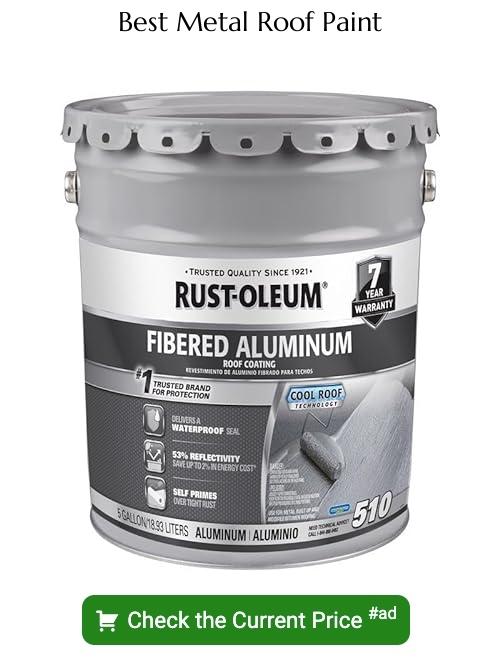Last updated on
This how-to guide will equip you with the step-by-step process to effectively paint a metal roof, ensuring quality results that last over time.
Key takeaways:
- Benefits of painting a metal roof: Boosts curb appeal, saves energy, protects against rust.
- Tools and paint needed: Acrylic latex paint, rust-inhibiting primer, brushes, rollers.
- Safe preparation and painting techniques: Clear debris, repair damage, apply primer, use even strokes.
- Mistakes to avoid: Neglecting roof cleaning, selecting wrong paint type, ignoring weather conditions.
- Maintenance and repainting tips: Regular inspections, proper cleaning, record maintenance activity.
Benefits of Painting Your Metal Roof

Enhancing your metal roof with a fresh coat of paint not only boosts the curb appeal of your home but also provides a range of practical advantages. The reflective properties of certain roof paints can lead to significant energy savings by deflecting sunlight and lowering heat absorption. This, in turn, reduces the workload on your cooling systems during hot months.
Moreover, painting helps protect the metal from the elements, warding off rust and corrosion that can compromise the roof’s integrity. A suitably chosen paint can also seal minor imperfections and prevent moisture penetration, extending the roof’s lifespan and its performance.
Regular maintenance, combined with painting, ensures that your metal roof continues to provide robust protection for your home while maintaining its aesthetic value. Remember, the benefits are maximized when the right materials and methods are used in the painting process.
What Tools and Paint You Will Need
Selecting the right tools and materials is crucial for a successful metal roof painting project. Choose a high-quality acrylic latex paint designed specifically for metal roofing to ensure adhesion and durability. A rust-inhibiting primer will prevent corrosion and help the topcoat adhere better.
For the application, you will need:
- Brushes: High-quality brushes are essential for cutting in and detailed work. A 2-inch angled brush is versatile and precise.
- Rollers: Use a roller with a minimum 3/4-inch nap to ensure you cover the textured surfaces of the metal roof.
- Paint sprayer: For larger roofs, a paint sprayer can provide a more uniform finish and expedite the process.
- Extension poles: They will enable you to reach higher areas and reduce the need for constant ladder movement.
Safety equipment is non-negotiable:
- Ladder: Ensure it’s sturdy and appropriate for your roof’s height.
- Harness: A safety harness can prevent falls when working on high or steep roofs.
- Shoes: Choose non-slip footwear to ensure safe movement on the roof.
Additional supplies include:
- Painter’s tape: Protect areas like gutters and flashing from drips.
- Drop cloths: Shield landscaping and surrounding areas from paint spills.
- Cleaning tools: Pressure washer or hose, along with a cleanser suited for metal roofing, is required for prepping the roof.
Ensure all chosen products are suitable for outdoor use and compatible with the metal of your roof.
Safe Roof Preparation and Painting Techniques
Begin with safety measures: wear non-slip shoes, use a secure ladder, and consider a safety harness.
Clear debris and rust from the metal surface using a wire brush or pressure washer, and ensure the roof is dry before proceeding.
Repair any damage, such as holes or leaks, and seal seams with urethane roof cement.
Apply a metal primer formulated for galvanized metal or treated metal, depending on your roof type, to enhance paint adhesion and corrosion resistance.
Follow with a paint specifically designed for metal roofing, applying with a roller or airless sprayer in even, overlapping strokes.
Opt for mild weather conditions – a dry day with mild temperatures and low wind – to ensure proper paint application and drying time.
Lastly, work systematically, starting at the peak and moving downward to maintain a safe standing position and avoid painting yourself into a corner.
Mistakes to Avoid When Painting Your Metal Roof
Neglecting Roof Cleaning: Before painting, it’s imperative to clean the metal roof thoroughly to remove any rust, dirt, and old paint residue. Skipping this step can lead to paint adhesion issues and premature peeling.
Selecting the Wrong Paint Type: Using paint that is not formulated for metal roofing or not suitable for outdoor use will lead to rapid deterioration. Always choose a high-quality, 100% acrylic latex paint or a paint specifically designed for metal roofs.
Ignoring Weather Conditions: Paint should not be applied during extreme weather conditions. High humidity and temperatures either below 50°F (10°C) or above 90°F (32°C) can affect the paint’s drying process and its overall performance.
Improper Application: Applying too thick a paint layer or uneven brush strokes may result in runs and sags. Even application with appropriate tools is critical for a professional finish.
Skipping Primer: Applying primer is crucial, particularly if the metal roof is galvanized or if there are any exposed metal areas after cleaning. Primer ensures better paint adhesion and increases the longevity of the paint job.
Overlooking Safety: Metal roofs are slippery, and working at heights is hazardous. Always use proper safety equipment, including non-slip shoes, safety ropes, and a harness to prevent falls and injuries.
Maintenance and Repainting Tips for Metal Roofs
Regular inspections play a crucial role in the longevity of your painted metal roof. Aim for twice-yearly checks, ideally in the spring and fall, to address any issues before they escalate. Look for peeling, chipping, or fading paint, as these signs indicate the need for touch-ups or repainting.
When performing touch-up work, clean the affected area thoroughly to ensure proper paint adhesion. Use the same type of paint originally applied to avoid chemical incompatibility and color mismatch.
To maintain the vibrancy of the paint, clean the roof annually with a solution of water and a non-abrasive cleaner. This removes accumulated dirt and organic growth that can degrade the coating if left unchecked.
Be mindful of the paint’s warranty, which typically ranges from 10 to 20 years. The warranty period can serve as a guideline for planning a full repaint, though environmental factors might necessitate earlier action.
For repainting, preparation is key. Remove old paint and rust, and apply a primer specifically designed for metal to ensure the success of your new coating. Employ the same methodical painting approach used during the initial application.
Lastly, keep records of all maintenance activity, including dates, products used, and the scope of work. This documentation will assist in future care and validate warranty claims if necessary.
FAQ
What kind of paint do you use on a metal roof?
The best type of paint to use on a metal roof is acrylic latex paint, or alternatively, a combination of oil-based alkyd paint and a galvanized metal primer.
Is painting a metal roof a good idea?
Yes, painting a metal roof is a beneficial practice as it provides additional weather protection, enhancing its resilience against elements like rain, wind, and UV rays.
Can you roll paint on a metal roof?
Yes, you can efficiently apply paint on a metal roof by using specially designed paint rollers for corrugated metal surfaces.
How often should a metal roof be repainted?
A metal roof should typically be repainted every five to ten years.
What is the step-by-step process for painting a metal roof?
The step-by-step process for painting a metal roof involves preparing the roof, priming it, and then applying a topcoat.
What are the costs associated with painting a metal roof?
The costs associated with painting a metal roof typically include professional labor fees, paint or coating cost, tools, and sometimes additional materials such as sealant or primer needed for the process.





